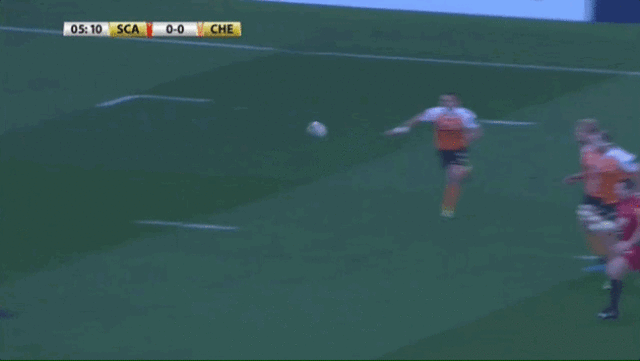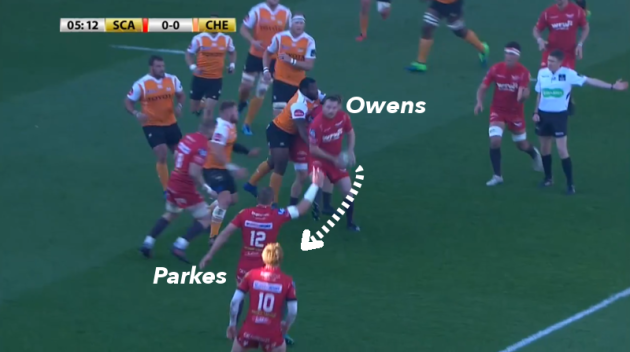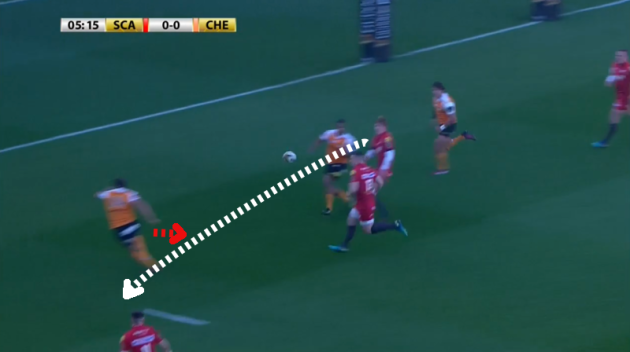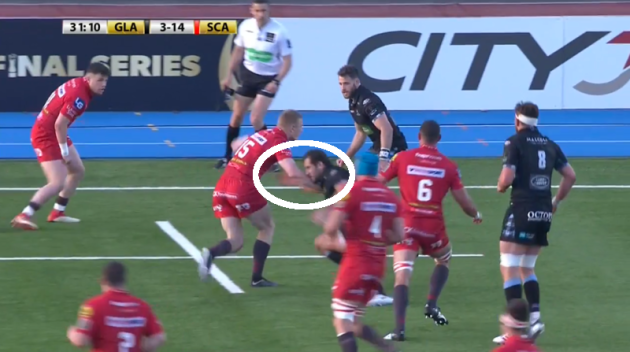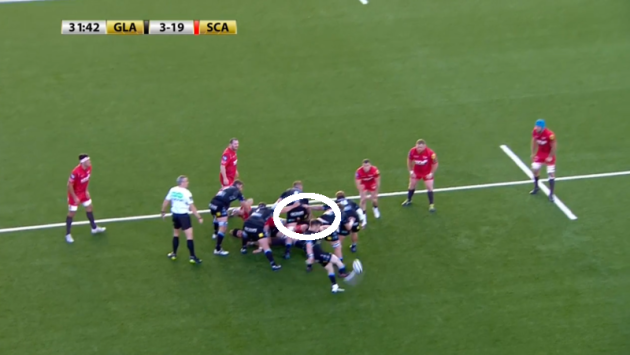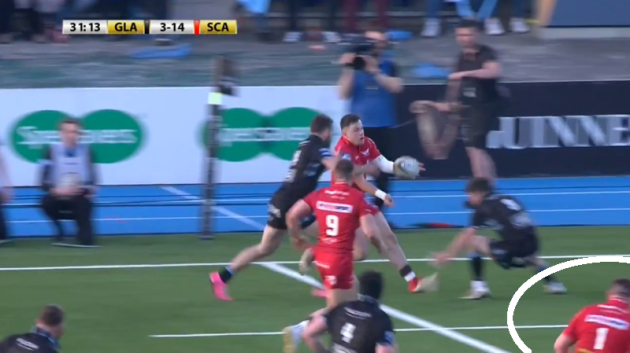NO OTHER TEAM in the Guinness Pro14 has scored more tries on turnover possession this season than the Scarlets.
Their 19 tries from possessions beginning with a turnover has them five clear of the next best in the championship, the Cheetahs.
The Welsh region’s ability on turnover possession is one of the reasons Leinster’s game plan in the sides’ Champions Cup semi-final made so much sense – narrower, based around brutal ball-carrying, with a focus on set-piece plays that had clearly been given plenty of training ground time.
Those tactics allowed Leinster to show a level of physicality that they believed the Scarlets couldn’t cope with, but it also limited the Welsh side’s turnover threat.
Simply put, give Wayne Pivac’s side turnover possession and they will score more often than not.
Click here if you cannot view the clip above
The example above is perhaps the easiest turnover score the Scarlets will enjoy all season, but there is a condensed insight into their mindset here.
Turnovers mean tries in the Scarlets’ mindset.
As highlighted below, it’s Scarlets hooker Ken Owens who gathers in the Cheetahs’ knock-on.
His first thought, within a split-second, is to move the ball away to space, whereas some front row forwards might look to carry and set-up a platform for their team to attack off.
We can see that centre Hadleigh Parkes has his arm raised, calling urgently for the ball too, and Owens obliges.
Parkes darts at the Cheetahs defence, tying in the first defender in front of him and moves the ball on to out-half Rhys Patchell, who is part of a three-on-two on the outside edge.
With the final Cheetahs defender having initially committed in on Scott Williams [red below], Patchell opts for the skip pass to Steff Evans.
The left wing has the easiest of finishes, crossing the whitewash seven seconds after Owens gathered the ball in.
The Scarlets are so good at the basic attack components of rugby – passing, fixing defenders, converting overloads of numbers – explaining why they are so effective in turnover situations.
It’s quite unlikely that Leinster will give up turnover possession to the Scarlets in the manner above, but their ruck work will need to be as ruthless as it was in the recent Champions Cup semi-final if they are to once again prevent the Welsh side’s turnover attack from flourishing.
While the Scarlets’ kick return hasn’t been quite as effective a platform – their seven tries mean a ranking of eighth in the Pro14 – the return of Johnny McNicholl last weekend at fullback boosted them in this department.
The Kiwi had been sidelined since February with a shoulder injury, but he made his presence felt returning kicks in their semi-final victory away to Glasgow Warriors.
The example below highlights his quality.
Click here if you cannot view the clip above
A long, uncontested box kick from Glasgow invites McNicholl to come back at them immediately and he does so with glee.
McNicholl uses his footwork to get to the outside shoulder of Fraser Brown and then fires out a powerful fend – Kiwi players are so good at this skill – to the Glasgow hooker’s upper chest/right shoulder area to beat him.
McNicholl then intelligently runs at Tommy Seymour’s inside shoulder to hold him, before skillfully flicking the ball one-handed to Steff Evans on the touchline.
While Evans is outside and beyond Seymour, he recognises that Glasgow scrum-half George Horne is sweeping across towards the touchline.
Evans is more than capable of beating defenders one-on-one but he understands that he will have support on his inside – Scarlets are excellent in this area, like Leinster – and instead cleverly swerves infield.
Scrum-half Gareth Davies [red above] is the man offering the option on Evans’ inside shoulder and Evans times the release of his pass perfectly, having drawn in Horne and the retreating Seymour.
Davies hurtles towards the tryline but Glasgow fullback Ruaridh Jackson is covering across and the Scarlets halfback needs support.
It comes in the slightly unlikely form of loosehead prop Rob Evans.
If we rewind back to the ruck that precedes this try, from where Glasgow box-kicked through Horne, Evans is actually on the ground at the bottom of the ruck.
As Evans gets off the ground and moves back downfield, he can see McNicholl gathering the kick uncontested and, as is the Scarlets way, his mindset is to instantly focus on what he can do to help the team score a try.
In this case, it involves halting his retreat downfield and turning back around in anticipation of a linebreak.
As we can see below, Evans is working hard to get to Davies’ inside shoulder as Steff Evans passes.
In truth, Evans hasn’t moved much at all after getting up off the ground from the ruck, but even in that lack of movement, the Scarlets’ appreciation for movement off the ball is underlined.
The loosehead prop is available to accept the pass inside from Davies and cross the tryline nine seconds after McNicholl has caught it to spark the kick return.
These aspects of the Scarlets’ game are, of course, only part of the picture but Leinster will appreciate the need to limit turnover opportunities and kick contestably or find row Z.
The42 is on Instagram! Tap the button below on your phone to follow us!
